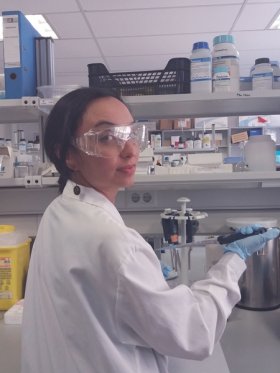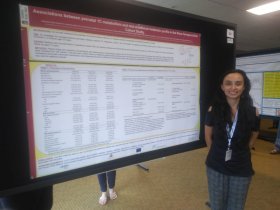Alejandra Rojas Gómez


PhD Programme: Biomedicine
Research group: Unitat de Medicina preventiva i Salut Pública
Supervisor: Michelle Murphy
Bio
Alejandra Rojas did her degree in Biology in Universidad Nacional de Colombia. Later, during her master's degree in Brazil (Universidade Federal do Rio Grande do Sul), her dissertation was about genetic variations, DNA methylation and perinatal outcomes in new-borns with prenatal exposure to crack and cocaine in Rio Grande do Sul. Her current research topic is the interactions between maternal genes and nutrients, the development of pregnancy and development in the offspring. She is specifically interested in the effects of the level of maternal folate and other related metabolites on metabolic markers of childhood, as well as its effect on epigenetic regulation.
Project: Prenatal gene-nutrient interactions and their relationship with development and health in the offspring
Inadequate pregnancy cobalamin status has been associated with adverse offspring health in Asia but there are few studies in countries with low prevalence of cobalamin deficiency. Less is known regarding the association between the betaine-dimethylglycine pathway during pregnancy, foetal growth and mid-childhood health. The associations between pregnancy fasting plasma total homocysteine (tHcy), cobalamin status (cobalamin, holotranscobalamin (holoTC), methylmalonic acid (MMA)) and mid-childhood (6-8y) metabolic score (MetSco) (including fat mass index, homeostatic model assessment of insulin resistance and dyslipidemia) were studied in a prospective study of 293 mother-child dyads. Associations between pregnancy fasting plasma betaine, dimethylglycine (DMG)/betaine, c.716G>A BHMT genotype and foetal growth were investigated in a prospective study of 748 mother-neonate dyads. The association between pregnancy fasting plasma betaine and mid-childhood (7.5 y) MetSco was investigated in 213 mother-child dyads. Child plasma metabolite status was studied according to pregnancy 1C metabolism status and bivariate correlations between child plasma metabolites and anthropometric measurements in 238 children were studied to identify potential biomarkers associated with the metabolic syndrome. Moderately elevated pregnancy tHcy, low holoTC and high MMA were associated with increased mid-childhood MetSco in boys. Cord plasma betaine was inversely associated with foetal growth. Babies born to mothers with the BHMT c.716 AA genotype had a higher risk of small for gestational age (SGA) compared to GG, and GA+GG genotypes. The pregnancy betaine-DMG pathway was not associated with child MetSco. Plasma betaine was higher in children born to mothers in the lowest tertile of pregnancy plasma cobalamin compared to the mid-high tertiles, while plasma tryptophan was lowest in those born to mothers in the highest vs low-mid maternal pregnancy plasma tHcy tertiles. Child plasma betaine, cysteine, 3-hydroxyanthranilic acid, kynurenic acid, histidine and asymmetric dimethylarginine were positively correlated with adiposity while picolinic acid, trigonelline and neopterin were negatively associated.
Open Access publications
- Cavallé-Busquets P, Inglès-Puig M, Fernandez-Ballart JD, Haro-Barceló J, Rojas-Gómez A, Ramos-Rodriguez C, Ballesteros M, Meyer K, Ueland PM, Murphy MM. Moderately elevated first trimester fasting plasma total homocysteine is associated with increased probability of miscarriage. The Reus-Tarragona Birth Cohort Study. Biochimie. 2020 Jun; 173:62-67. View full-text
- PHD THESIS: Prenatal gene-nutrient interactions and their relationship with development and health in the offspring
International secondment
- University of British Columbia, Canada. 3 months (2021).
Outreach activities
- European Researchers’ Night 2020: “Viatge a l'invisible: com extreure i veure ADN a casa”.
News
- Diari Digital de la URV. News: Researchers of URV have linked prenatal 1C metabolism and mid-childhood metabolic profile



